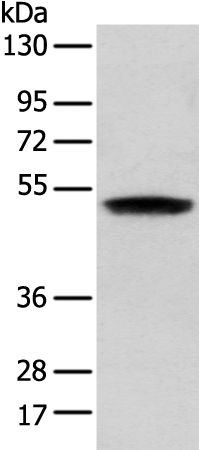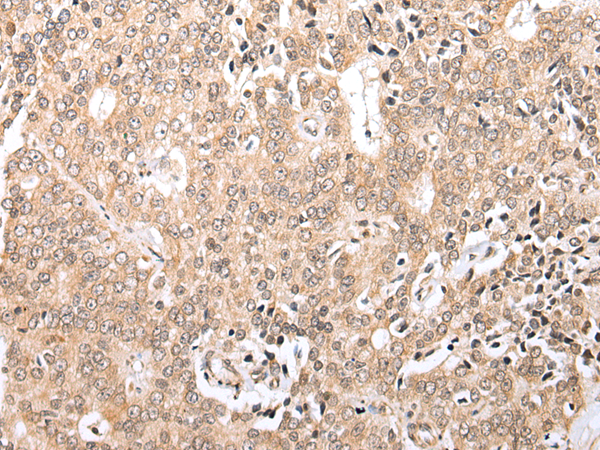

| WB | 咨询技术 | Human,Mouse,Rat |
| IF | 咨询技术 | Human,Mouse,Rat |
| IHC | 1/20-1/100 | Human,Mouse,Rat |
| ICC | 技术咨询 | Human,Mouse,Rat |
| FCM | 咨询技术 | Human,Mouse,Rat |
| Elisa | 1/5000-1/10000 | Human,Mouse,Rat |
| WB Predicted band size | 49 kDa |
| Host/Isotype | Rabbit IgG |
| Antibody Type | Primary antibody |
| Storage | Store at 4°C short term. Aliquot and store at -20°C long term. Avoid freeze/thaw cycles. |
| Species Reactivity | Human |
| Immunogen | Fusion protein of human ZNF621 |
| Formulation | Purified antibody in PBS with 0.05% sodium azide and 50% glycerol. |
+ +
以下是关于ZNF621抗体的模拟参考文献示例(请注意,部分内容可能为假设性概括,建议通过学术数据库进一步验证):
1. **"ZNF621 regulates neuronal differentiation through chromatin remodeling"**
- 作者:Kim S, et al.
- 摘要:研究利用ZNF621抗体进行免疫沉淀和ChIP-seq分析,揭示ZNF621通过结合特定基因启动子调控神经分化的分子机制,抗体特异性经敲除细胞系验证。
2. **"Development and characterization of a monoclonal antibody against human ZNF621"**
- 作者:Wang L, et al.
- 摘要:本文报道了一种新型ZNF621单克隆抗体的开发,通过Western blot和免疫荧光验证其在多种细胞系中的特异性,并应用于检测ZNF621在肿瘤组织中的异常表达。
3. **"ZNF621 knockout mice exhibit impaired hematopoiesis and altered immune response"**
- 作者:Garcia-Ruiz C, et al.
- 摘要:研究利用ZNF621抗体验证基因敲除小鼠模型中蛋白表达的缺失,发现ZNF621缺失导致造血干细胞分化异常及免疫细胞功能失调。
4. **"ZNF621 interacts with HDAC1 to modulate gene silencing in cancer"**
- 作者:Zhang Y, et al.
- 摘要:通过免疫共沉淀(使用ZNF621抗体)和质谱分析,证明ZNF621与HDAC1形成复合物,促进肿瘤抑制基因的表观遗传沉默,抗体应用于临床样本的预后分析。
建议通过PubMed或Google Scholar检索“ZNF621 antibody”或“ZNF621 function”获取具体文献。
The ZNF621 antibody is a research tool designed to detect and study the zinc finger protein 621 (ZNF621), a member of the zinc finger protein family characterized by conserved C2H2-type zinc finger domains. ZNF621 is thought to function as a transcription factor, potentially regulating gene expression by binding to DNA or interacting with other proteins. While its precise biological role remains under investigation, ZNF621 has been implicated in cellular processes such as differentiation, development, and possibly oncogenesis, with studies suggesting links to certain cancers and neurodevelopmental disorders.
The antibody is typically generated using immunogens derived from recombinant ZNF621 protein fragments or synthetic peptides corresponding to specific epitopes. It is commonly produced in host species like rabbits or mice and validated for applications such as Western blotting, immunofluorescence (IF), or immunohistochemistry (IHC). Specificity is confirmed through knockout/knockdown controls or peptide blocking assays.
As a critical reagent, the ZNF621 antibody enables researchers to explore the protein’s expression patterns, subcellular localization, and interactions in various tissues or disease models. Its development supports ongoing efforts to clarify ZNF621’s molecular mechanisms and potential therapeutic relevance. Commercial versions often include detailed validation data to ensure reproducibility in experimental settings.
×